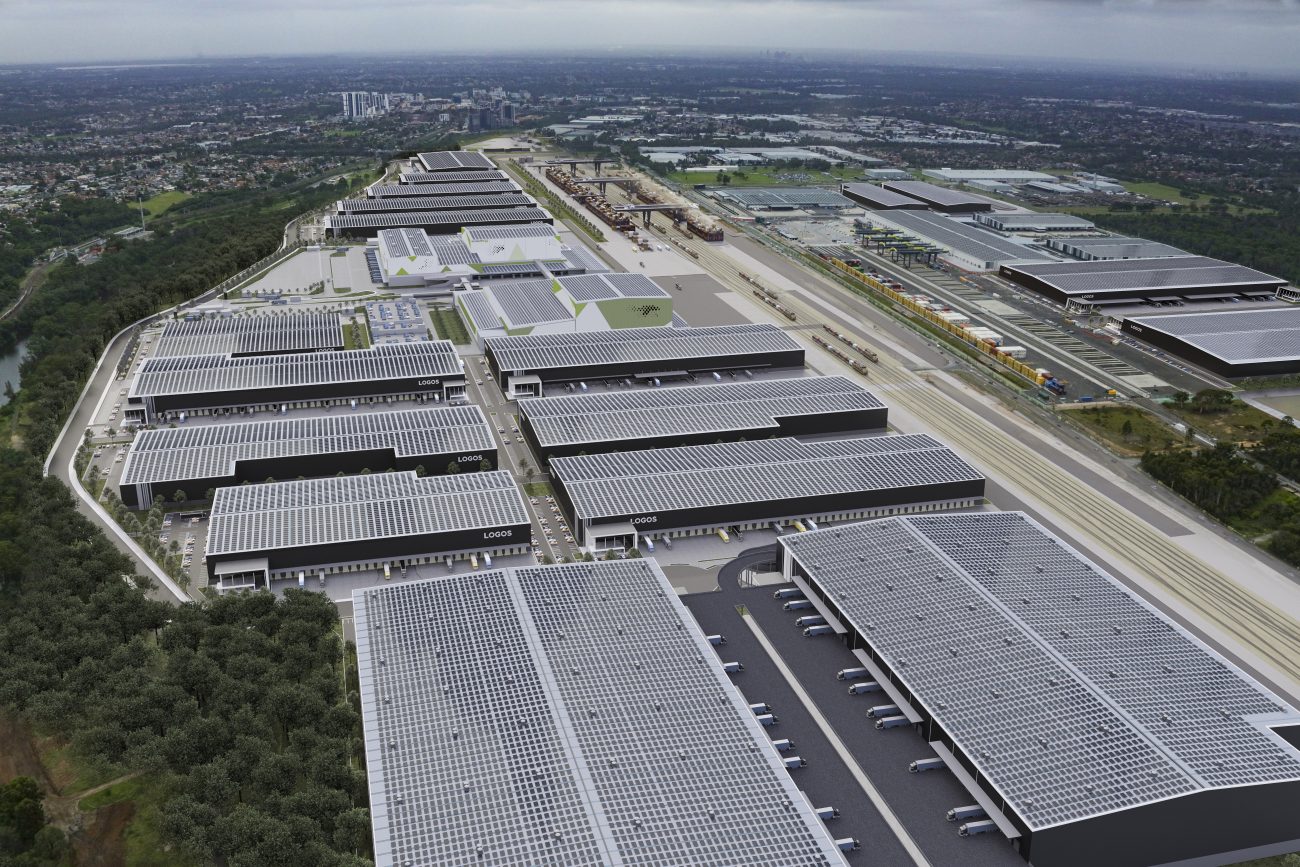Australia’s largest rooftop build for Moorebank Logistics Park
Today, leading Asia-Pacific logistics specialist LOGOS and its partners are pleased to announce a 30-year partnership with Renewables Fund, Solar Bay, part of Energy Bay, to install and operate Australia’s largest rooftop solar installation.
Moorebank Logistics Park (“MLP”) is Australia’s largest intermodal freight facility and will be a fully automated port-to-site rail link and world-leading industrial and warehousing site, facilitating logistics and warehousing for some of Australia’s leading customers. Solar Bay, part of Energy Bay is a Renewable Energy Fund that installs, owns, and operates energy infrastructure across Australia and New Zealand. This infrastructure generates and distributes renewable electricity for on-site use by tenants and landlords.
Solar Bay, part of Energy Bay will provide network and retail energy services to tenants within MLP, by installing 60MW of rooftop solar across the estate and 150MWh of battery energy storage to supply the embedded network with renewable electricity. The combined power of this rooftop solar and battery energy will generate enough clean energy to power the equivalent of 40,000 homes in NSW, avoiding an estimated 67.2 kilotonnes of CO2 emissions each year. Once fully operational, the solar micro-grid will be capable of supplying the full energy requirement of the precinct during daylight hours, and source electricity from an off-site wind farm to supply renewable electricity outside peak solar generation periods.
With over 800,000sqm of roof space at the precinct the site has the capacity for up to 130MW of rooftop solar, capable of generating 183GWh of electricity per annum. Future stages of the microgrid will utilise additional solar generation for Electric Truck fast charging, thermal storage, hydrogen generation and supply, and related low emission infrastructure.
LOGOS, together with LOGOS Consortium partners, AustralianSuper, Ivanhoé Cambridge, TCorp (NSW Treasury Corporation) and AXA IM Alts (the “LOGOS Consortium”), finalised their $1.67 billion acquisition of MLP on 15th December 2021, in a landmark investment. The end estimated value of MLP is $4.2 billion once the site is fully developed and will be Australia’s largest logistics warehousing infrastructure project.
The LOGOS Consortium said: “We are proud to make such a significant announcement in Australia’s renewable energy sector today, which will reap environmental benefits and innovation for a long time to come. We are committed to developing MLP with leading sustainability practices and outcomes at the fore, and our partnership with Solar Bay, part of Energy Bay will allow the LOGOS Consortium to utilise the latest technologies so that we can produce, store, manage, and use energy more efficiently on-site at MLP and run all warehouse operations on 100% renewable energy.”
Head of LOGOS Australia and New Zealand, Darren Searle, said: “The implementation of this green infrastructure at MLP will accelerate our achievement of green scale and ensure that our operations are running at net-zero emissions by 2040. The impacts of the infrastructure that we will develop with Solar Bay, part of Energy Bay at MLP will extend far beyond the site itself and play a key role in the state, regional and local economies given the size, scale and influence of our market-leading site. It also offers substantial opportunity to the tenants of MLP, where they seek to run their own business operations on a carbon-neutral mandate.
“The LOGOS Consortium will develop and fund the construction of the embedded network, with our long-term partnership with Solar Bay, part of Energy Bay delivering the ongoing operation of this network. This maximises outcomes for all involved – from Solar Bay, part of Energy Bay as the operator, to LOGOS as the investment and development manager, to our tenants, with the economies of scale at MLP offering a distinct, market-leading advantage with the amount of renewable energy provided through a microgrid. We look forward to continuing to contribute to ongoing innovation in the logistics sector globally.”
Investment Director at Solar Bay, part of Energy Bay, James Doyle said: “MLP is a prime example of the convergence between property and energy infrastructure that we’re seeing across Australia and New Zealand. A precinct wide microgrid facilitates the on-site installation of utility scale solar and batteries, providing tenants with the ability to access a vast amount of renewable electricity that match the scale of their electrified operations. With over 800,000sqm of rooftop solar possible we can also assist in the decarbonisation of transport and utilise surplus generation to produce low emission fuels such as Hydrogen. Solar Bay, part of Energy Bay is excited to be involved with the rollout of the renewable infrastructure at MLP, and see it setting a strong precedent for what’s possible at Industrial precincts moving forward.”
Together, LOGOS and Solar Bay, part of Energy Bay will develop the precinct-wide microgrid, which will operate at a combination of 11kV and 33kV to provide the required electrical capacity to tenants. The rooftop solar and battery storage system will connect into the high voltage network at multiple points, with complementary technology such as megawatt scale electric vehicle/truck fast chargers also able to be integrated throughout the precinct. With a number of the significant loads at MLP able to be flexed in real time, the site be will also interact with the National Energy Market (“NEM”). This will be completed to optimise the consumption of on-site generation and provide services back to the NEM when required, via demand response and the ancillary market.
When complete, approximately 44% of the total site electrical requirement will be provided via the on-site generation, with the remaining power required coming from an off-site wind farm. The combination of this infrastructure allows Solar Bay, part of Energy Bay to offer tenants long term electricity supply agreements such as the Qube IMEX and Interstate rail operations which have a 20-year agreement in place.
The solar panels will also provide clean energy for the warehouse and container terminal operations, which will further reduce freight transport emissions into the future by promoting rail over road transport.
